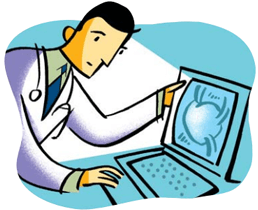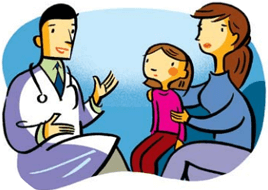
The TEE is done by a cardiology doctor who specializes in the care of patients with heart problems. It is done under sedation because your child needs to be very calm for it. Although not fully asleep, your child will not feel any pain during the test or remember it afterwards.
During the test, your child’s heart rate, rhythm, breathing and blood pressure will be checked carefully. The test takes about 30 minutes and the pictures taken of the heart will be recorded so a doctor can look at them later.
- Your child will be asked to take off all clothes down to his or her underpants and put on a hospital gown.
- A member of the hospital’s anesthesia team will meet with you and your child to make sure he or she has not had any food or liquids before the test and ask you any other important questions about your child’s health.
- The doctor who will do your child’s test will come to meet you and your child before the test begins. At that time, you may ask any questions you may have about the test.
- A nurse will come to get your child when it is time for him or her to move into the room where the test will be done. Parents will be asked to wait in the Same Day Surgery waiting area.
- Once your child is in the testing room, an intravenous (IV) line will be placed into a vein in his or her arm. During the test, medicine will be given through the IV to make your child sleepy.
- To begin the test, small plastic stickers called electrodes (e-LECK-trodes) will be placed on your child’s chest. Wires will be attached to the electrodes and then connected to a machine.
- A blood pressure cuff will be wrapped around your child’s arm to measure blood pressure frequently throughout the test.
- A light sensor will be taped to your child’s finger to measure the amount of oxygen in his or her blood.
- Medicine will be sprayed into the back of your child’s throat and mouth to numb the area, and then a medicine will be given through the IV to make your child sleepy.
- To make it easy for your child to breathe during the test, a cannula (CAN-u-la) will be placed inside his or her nostrils. A cannula is a connected pair of small, soft plastic tubes that will carry oxygen for your child to breathe during the test.
- Your child will lie on his or her left side and a bite block, a small plastic block with a hole in the center, will be placed between the upper and lower teeth. This block will allow the long, thin wand to be passed through your child’s mouth without being bitten. The wand attaches with a thin cord to the sound wave (ultrasound) machine.
- Your child will be asked to swallow as the wand is passed into his or her mouth through the hole in the bite block. The wand will be covered with a numbing gel to make swallowing easier. Even sleepy children are able to swallow when asked. Swallowing helps the doctor guide the wand into the esophagus. As the wand is passed into the back of the throat, it may cause gagging for a moment.
- After the wand is in place in the esophagus, the doctor will gently move it into different positions to take several pictures of the heart. Some of these pictures will be recorded onto a computer to be looked at later.
- The test may take 30 to 60 minutes, depending on how many pictures the doctor needs of your child’s heart.
- At the end of the test, the doctor will gently pull the wand out of the esophagus and remove the light sensor, blood pressure cuff and electrodes. Your child will not remember what happened during the TEE because of the medicine used to make him or her sleepy.









 At UPMC Children’s Hospital of Pittsburgh we believe parents and guardians can contribute to the success of this test, and we invite you to participate. Please read the following information to learn about the test and how you can help.
At UPMC Children’s Hospital of Pittsburgh we believe parents and guardians can contribute to the success of this test, and we invite you to participate. Please read the following information to learn about the test and how you can help.